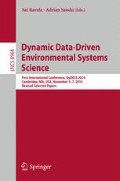Abstract
Optimizing wells placement may help in better understanding subsurface solute transport and detecting contaminant plumes. In this work, we use the ensemble Kalman filter (EnKF) as a data assimilation tool and propose a greedy observational design algorithm to optimally select aquifer wells locations for updating the prior contaminant ensemble. The algorithm is greedy in the sense that it operates sequentially, without taking into account expected future gains. The selection criteria is based on maximizing the information gain that the EnKF carries during the update of the prior uncertainties. We test the efficiency of this algorithm in a synthetic aquifer system where a contaminant plume is set to migrate over a 30 years period across a heterogenous domain.
Access this chapter
Tax calculation will be finalised at checkout
Purchases are for personal use only
References
Cavagnaro, D.R., Myung, J.I., Pitt, M.A., Kujala, J.V.: Adaptive design optimization: a mutual information-based approach to model discrimination in cognitive science. Neural Comput. 22, 887–905 (2012)
Choi, H.-L., How, J.P.: Efficient targeting of sensor networks for large-scale systems. IEEE Trans. Control Syst. Technol. 19, 1569–1577 (2011)
Choi, H-L., How, J.P., Hansen, J.A.: Ensemble-based adaptive targeting of mobile ensor networks. In: Proceedings of the 2007 American Control Conference. ThA09.3, pp. 2393–2398 (2007)
Gharamti, M.E., Valstar, J., Hoteit, I.: Dual states estimation of a subsurface flow-transport coupled model using ensemble Kalman filtering. Adv. Water Resour. 60, 75–88 (2013)
Gharamti, M.E., Kadoura, A., Valstar, J., Sun, S., Hoteit, I.: Constraining a compositional flow model with flow-chemical data using an ensemble-based Kalman filter. Water Resour. Res. 50, 2444–2467 (2014)
Huan, X., Marzouk, Y.M.: Simulation-based optimal Bayesian experimental design for nonlinear systems. J. Comput. Phys. 232(1), 288–317 (2013)
Huan, X., Marzouk, Y.M.: Gradient-based stochastic optimization methods in Bayesian experimental design. Int. J. Uncertainty Quantification 4(6), 479–510 (2014). doi:10.1615/Int.J.UncertaintQuantification.2014006730
Kullback, S., Leibler, R.A.: On information and sufficiency. Ann. Math. Stat. 22, 79–86 (1951)
Majumdar, S.J., Bishop, C.H., Etherton, B.J., Szunyogh, I., Toth, Z.: Can an ensemble transform Kalman filter predict the reduction in forecast error variance produced by targeted observations? Q. J. Roy. Meteorol. Soc. 126, 1–999 (2000)
Solonen, A., Haario, H., Laine, M.: Simulation-based optimal design using a response variance criterion. J. Comput. Graph. Stat. 21, 234–252 (2012)
Yakirevich, A., Pachepsky, Y.A., Gish, T.J., Guber, A.K., Kuznetsov, M.Y., Cady, R.E., Nicholson, T.J.: Augmenting of groundwater monitoring networks using information theory and ensemble modeling with pedotransfer functions. J. Hydrol. 501, 13–24 (2013)
Author information
Authors and Affiliations
Corresponding author
Editor information
Editors and Affiliations
Rights and permissions
Copyright information
© 2015 Springer International Publishing Switzerland
About this paper
Cite this paper
Gharamti, M.E., Marzouk, Y.M., Huan, X., Hoteit, I. (2015). A Greedy Approach for Placement of Subsurface Aquifer Wells in an Ensemble Filtering Framework. In: Ravela, S., Sandu, A. (eds) Dynamic Data-Driven Environmental Systems Science. DyDESS 2014. Lecture Notes in Computer Science(), vol 8964. Springer, Cham. https://doi.org/10.1007/978-3-319-25138-7_27
Download citation
DOI: https://doi.org/10.1007/978-3-319-25138-7_27
Published:
Publisher Name: Springer, Cham
Print ISBN: 978-3-319-25137-0
Online ISBN: 978-3-319-25138-7
eBook Packages: Computer ScienceComputer Science (R0)

